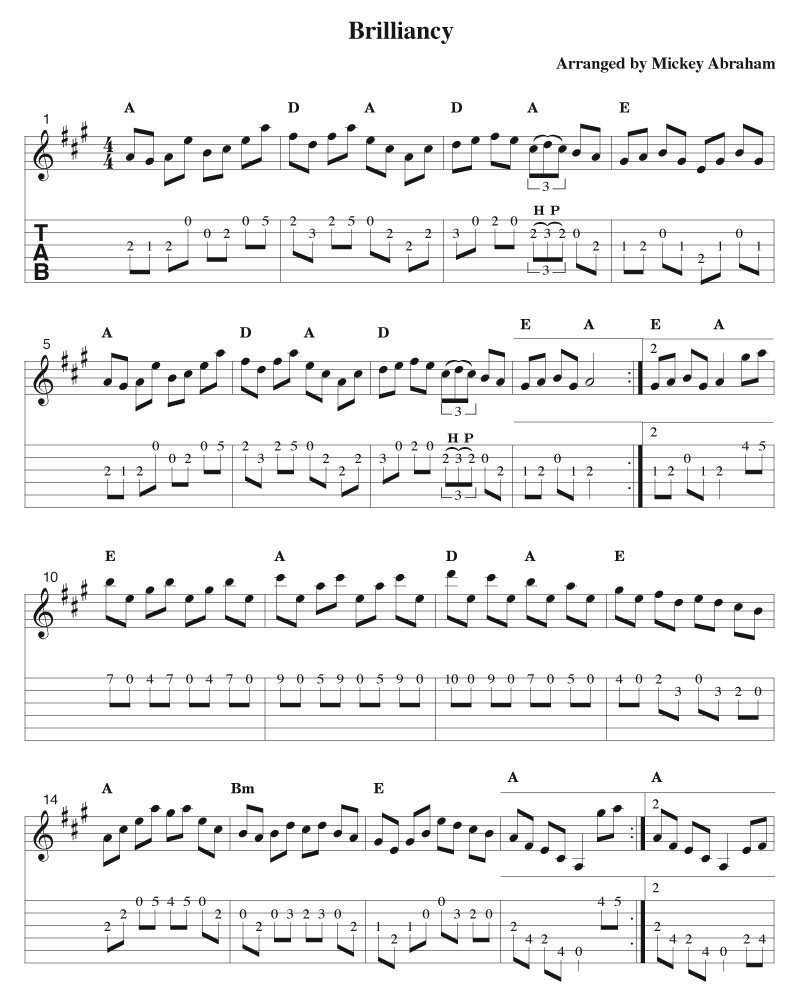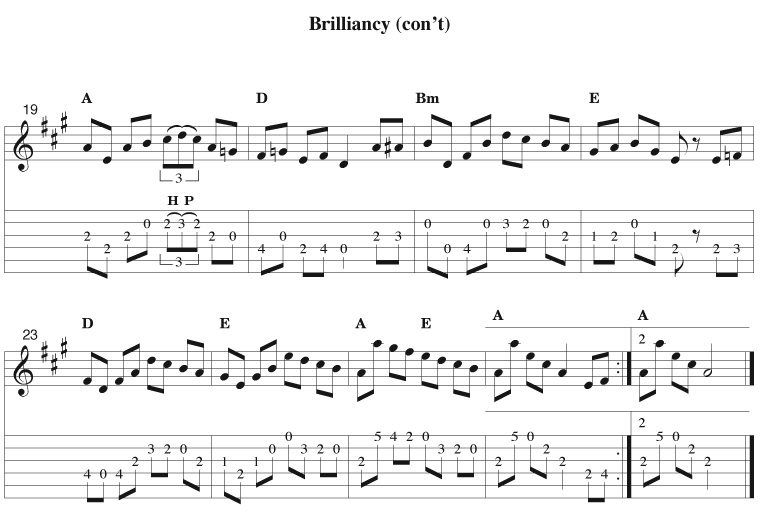|
February 2011 Free Flatpicking Lesson
from
Flatpicking Guitar Magazine
"Brilliancy"
by Mickey Abraham
Hello, and welcome to Flatpicking Guitar Magazine’s free
monthly flatpicking lesson. This month I have chosen to share a
beautiful tune from the Irish fiddling tradition entitled “Brilliancy.”
This tune has always fascinated me due to its amazing use of
arpeggios, unique feel, and understated simplicity. I’m certain you
will find this melody pleasing to your fingers and your ears. Since
this is a lesson, it should go without saying, but practice slowly and
carefully, paying attention to your technique (pick strokes,
corrected hand positions, and timing). In the end, you will be a
cleaner and more musical musician!
Let’s first take a look
at the overall construction of the tune. The song is in the key of A
and has three parts. Each part is eight measures long and each part
is played twice. I love fiddle tunes that have a third part, they
seem to take the listener on a melodic journey and often save the
coolest part for last. Check out out the lesson mp3 to hear how the
third part really sums up the musical message that “Brilliancy” is
trying to convey. Most fiddle tunes ended up with two sections to
match the old-time contra dances. Some tunes used to have three parts
but, over time, they began being taught and played as two part tunes
like “St. Anne’s Reel” and “Big Mon.”
The melody to “Brilliancy”
reminds me of almost a classical/baroque piece of music, but with an
Irish hornpipe bounce. The use of chord arpeggios and wide intervalic
passages makes the tune sound very advanced and difficult, but this
arrangement falls quite nicely on the fingerboard. I play the entire
first and third sections out of 2nd position except for the few times
where I use my first two fingers on the first two frets. The open
strings allow me to shift up and down with ease. You will never hear
my fingers swishing against the strings because I shift while the open
strings are ringing.
This “open string” concept
becomes even more important when tackling the second part. At first,
you will be in fourth position using your index and pinky for the
fourth and seventh frets. Next, you will be in fifth position for the
following phrase that uses the fifth and ninth frets. In order to
move positions smoothly, is is crucial to let the open string before
and after the position shift ring out -- this way you will have,
literally, ONE beat of musical time to get your left hand to where it
needs to go. This shifting technique is used by all the great
flatpickers.
For the backup, there is
nothing too tricky here. I based the chords almost entirely on the
classic I, IV, V progression, which in this case, is A, D, and E. You
will, however, encounter a Bm (the II chord in the key of A) twice. I
really enjoy the movement the Bm gives the piece. But, to be honest, I
find the backup very secondary -- in some ways, this tune is so
melodically intriguing that it almost does not need a chord player. The
notes are based so heavily on outlined chord shapes and melodic
ideas, that many of the chords are “implied” while picking the
melody. This is a sign of a well thought out tune!
I hope you enjoy working on
“Brilliancy” and adding this fantastic tune to your list. If you have
any questions or comments on this e-lesson or great ideas for future
e-lessons you’d like to see featured here, just drop me a line at [email protected].


|